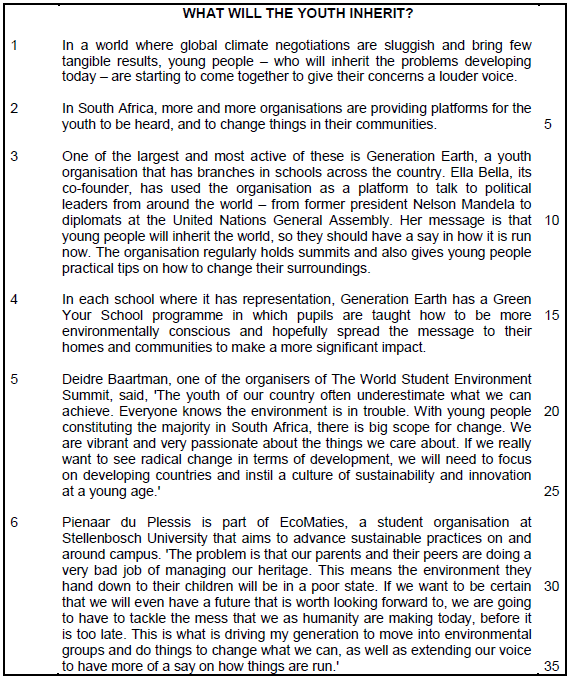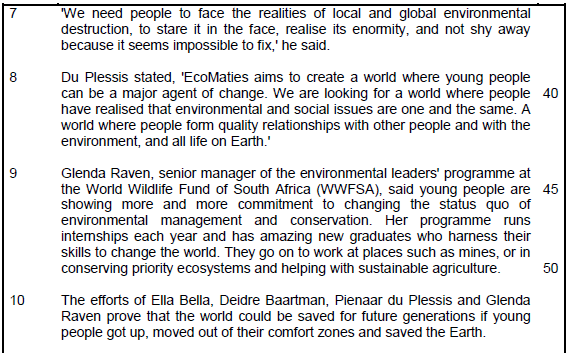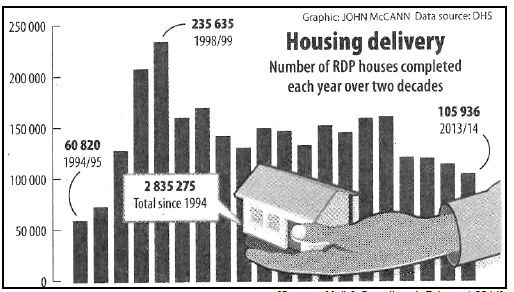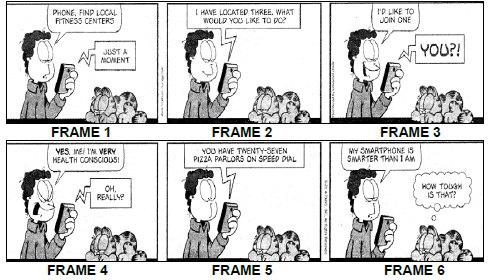ENGLISH FIRST ADDITIONAL LANGUAGE PAPER 1 GRADE 12 QUESTIONS - NSC PAST PAPERS AND MEMOS FEBRUARY/MARCH 2016
Share via Whatsapp Join our WhatsApp Group Join our Telegram GroupENGLISH FIRST ADDITIONAL LANGUAGE P1
FEBRUARY/MARCH 2016
NATIONAL SENIOR CERTIFICATE
GRADE 12
INSTRUCTIONS AND INFORMATION
- This question paper consists of THREE sections:
- SECTION A:Comprehension (30)
- SECTION B:Summary (10)
- SECTION C:Language (40)
- Answer ALL the questions.3.
- Read ALL the instructions carefully.
- Start EACH section on a NEW page.
- Leave a line between answers.
- Number the answers correctly according to the numbering system used in this question paper.
- For multiple-choice questions, write only the question number and the letter (A–D) of the correct answer.
- Pay special attention to spelling and sentence construction.
- Use the following time frames as a guideline:
- SECTION A: 50 minutes
- SECTION B: 30 minutes
- SECTION C: 40 minutes
- Write neatly and legibly.
SECTION A: COMPREHENSION
QUESTION 1
Read BOTH TEXT A and TEXT B and answer the set questions.
TEXT A


NOTE:
- Answer ALL the questions in your OWN WORDS.
- For one-word answers, write only the question number and the word.
1.1 Name TWO youth organisations that aim to change communities' attitudes towards the environment in South Africa. (2)
1.2 What does the word 'sluggish' (line 1) suggest about negotiations that take place? (1)
1.3 Quote a SINGLE word to prove the following statement FALSE:
Ella Bella is the only founder of Generation Earth. (1)
1.4 Why did Ella Bella decide to talk to political leaders like Nelson Mandela? (3)
1.5 Explain how the Green Your School programme promotes care of the environment. (2)
1.6 State TWO reasons why, according to Deidre Baartman, the youth may succeed in ensuring a greener Earth in future. (2)
1.7 What, according to Deidre Baartman, are TWO effective ways of ensuring a greener world? (2)
1.8 Discuss Pienaar du Plessis's statement, 'The problem is that our parents and their peers are doing a very bad job at managing our heritage'. (3)
1.9 Explain how environmental and social issues are 'one and the same' (line 41). (3)
1.10 What does Pienaar du Plessis mean by, 'moved out of their comfort zones' in line 53? (2)
1.11 What makes the title, 'What will the youth inherit?' suitable for this article? Substantiate your response. (3)
TEXT B
 |
Refer to the illustration above (TEXT B).
1.12 Choose the correct answer to complete the following sentence:
The phrase 'two decades' means ...
- two years.
- twenty years.
- ten years.
- two hundred years. (1)
1.13 What does the hand holding a house represent? (2)
1.14 According to the graph, when was housing delivery at its highest? (1)
1.15 Why has the information on housing been presented in the form of a graph instead of words? (2)
TOTAL SECTION A: 30
SECTION B: SUMMARY
QUESTION 2
You have been asked to write an article for your local newspaper on the importance of road safety education for learners.
Read the passage below (TEXT C) and list SEVEN important points on road safety education for learners that you will include in your article.
INSTRUCTIONS
- Your summary must be written in point form.
- List your SEVEN points in full sentences, using not more than 70 words.
- Number your sentences from 1 to 7.
- Write only ONE point per sentence.
- Use your OWN words as far as possible.
- Indicate the total number of words you have used in brackets at the end of your summary.
TEXT C
ADDRESSING ROAD SAFETY The United Nations has declared the period 2011–2020 as the Decade of Action for Road Safety, urging countries to reduce the number of fatalities caused by road accidents. They argue that road traffic injuries are among the three leading causes of death for people between the ages of five and forty-four years. Statistics rank South Africa's road accident fatality rate among the five highest in the world. In 2013, a three-year research project was launched in South Africa to determine road safety behaviour of primary school learners. It is important to observe children confronted with real-life road safety situations and assess their decision-making skills and attitude towards road safety. It was found that children do not use designated areas to walk on and to cross the road. The lack of road signs and pavements, shortage of pedestrian crossings and no traffic officers visible contributed to this behaviour among learners. The fundamental idea is that no one needs to die or be seriously injured in road accidents, as these can be prevented. Therefore, the South African Department of Basic Education has been involved in partnerships with road safety organisations in influencing responsible learner behaviour on the road. In South Africa, road safety education forms part of the curriculum in Life Orientation and other subjects. The main aim of road safety education should be to change road behaviour, which implies the need for practical education. Road safety education and training should not be just for learners, but for all members of society. This will promote road safety at all levels. |
TOTAL SECTION B: 10
SECTION C: LANGUAGE
QUESTION 3: ANALYSING AN ADVERTISEMENT
Study the advertisement (TEXT D) below and answer the set questions.
TEXT D
Tshwane's strength lies in the rich variety of its natural, historical and cultural heritage. Its warm and pleasant climate – hot summers and cool, dry winters – makes it an ideal tourist destination all year round. It is the home of jazz and is also renowned as the country's capital of performing and visual arts, boasting several art galleries. The State Theatre and smaller theatres regularly stage a wide variety of exceptional productions in all genres and feature local and international artists. For those who love to shop, Menlyn Park Shopping Centre – one of the biggest retail destinations in the Southern Hemisphere – is the place to be.
|
3.1 State what is being advertised. (1)
3.2 Explain how the picture is linked to the words, 'COME AND EXPERIENCE THE CAPITAL!' (2)
3.3 Explain why Tshwane is 'an ideal tourist destination all year round'. (2)
3.4 How will this advertisement appeal to people who are interested in the arts? State TWO points. (2)
3.5 According to this advertisement, why is the Menlyn Park Shopping Centre described as 'the place to be'? (1)
3.6 In your view, how does this advertisement support the slogan, 'Igniting Excellence'? Substantiate your answer. (2) [10]
QUESTION 4: ANALYSING A CARTOON
Read the cartoon (TEXT E) below and answer the set questions.
TEXT E
GARFIELD
|
| NOTE: In this cartoon, the cat is Garfield and the man having a conversation with his smartphone is Jon. |
4.1 What evidence is there in frame 1 that this is an American cartoon? (1)
4.2 Refer to frame 3.
What TWO techniques does the cartoonist use to show that the smartphone is shocked? (2)
4.3 Refer to frame 5.
Why does Jon's facial expression change? (2)
4.4 How does the cartoonist show that Garfield is not talking in frame 6? (1)
4.5 Consider the cartoon as a whole. Why is there no change in Garfield's body language and facial expression? (2)
4.6In your opinion, will teenagers enjoy reading this cartoon? Discuss your answer. (2) [10]
QUESTION 5: LANGUAGE AND EDITING SKILLS
5.1 Read the passage (TEXT F) below, which has some deliberate errors, and answer the set questions.
TEXT F
DANCING UP A (DUST) STORM
|
5.1.1 Correct the SINGLE error in each of the following sentences. Write down ONLY the question numbers and the words you have corrected.
- Riel dancing, a traditional dance which dates back to Khoisan times, has long been practiced by sheep herders and farm workers (1)
- There is a revival of this dance under way – and its faster and more energetic than ever.(1)
- At a local festival in Clanwilliam, the dancers – who kick up plenty off dust – reduced at least two audience members to tears of joy.(1)
- 'Going to Wupperthal is like going back to time fifteen, twenty years,' said Floris Smith.(1)
5.1.2 Refer to lines 7–9. Name a different punctuation mark that can be used to replace the dashes. (1)
5.1.3 Give the correct words derived from those within brackets. Write down ONLY the question number and the words.
The (victory) dancers returned to a grand (celebrate). (2)
5.1.4 Identify the part of speech of each of the underlined words in the following sentence:
'When you dance the riel, there has to be dust,' says Charné, a curvy 16-year-old riel dancer with a bubbly laugh. (Lines 10–11) (2)
5.1.5 Rewrite the following sentence in the active voice:
A huge applause was received by the dancers. (1)
5.1.6Rewrite the following sentence as a tag question:
He is proud of the dance form. (2)
5.1.7 Choose the correct article in brackets. Write down ONLY the question number and the article.
Charné and the rest of the dance troupe stole the championship title from (a/an) host of other performers. (1)
5.1.8 Provide an antonym for the word old-fashioned in the following sentence:
Many people think of riel dancing as old-fashioned but now it includes hip-hop and kwaito, taking it to a new level. (1)
5.2 Study the text (TEXT G) below and answer the set questions.
TEXT G
NOTE: In this cartoon Hägar is speaking to a woman. |
5.2.1 Refer to 'I don't get no respect at home ...' (frame 1).
- Write out the word 'don't' in its complete form.(1)
- Rewrite the above sentence, correcting the grammar.(1)
5.2.2 Choose the correct answer to complete the following sentence:
The ellipsis (...) in frame 1 indicates ...
- a complete sentence.
- an emphasis.
- an incomplete sentence.
- an exclamation. (1)
5.2.3 Rewrite the following sentence in reported speech:
She said, 'You don't deserve respect anywhere!' (3) [20]
TOTAL SECTION C:40
GRAND TOTAL:80



